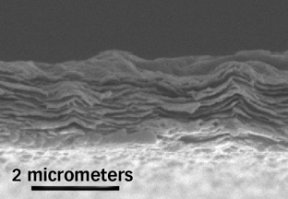Material mimics mother-of-pearl in form and substance
- More than 2 years ago
Gleaming, iridescent mother-of-pearl possesses more than beauty. The material, technically called nacre, has strength and toughness that materials scientists envy because it’s made of highly ordered layers.

Now, researchers have designed a synthetic material that mimics both nacre’s internal architecture and its strength.
Nicholas Kotov of Oklahoma State University in Stillwater and his colleagues modeled their material after natural mother-of-pearl, which gets its properties from a brick-and-mortar structure of calcium carbonate held together by a network of proteins. Natural nacre also benefits from so-called sacrificial ionic bonds between proteins, which break under stress but can reform.
Kotov and his coworkers programmed a robot to dip glass slides in alternating solutions of a negatively charged clay known as montmorillonite and a positively charged polymer called PDDA, short for poly(diallydimethylammonium) chloride. This process built up hundreds of layers of clay and polymer, each one a few nanometers thick. The clay acted the part of bricks while the polymer played the mortar.
What’s more, the resulting film contained sacrificial bonds between PDDA chains.
In mechanical tests, the material was as strong as nacre. The researchers describe their work in the June Nature Materials.
Kotov’s team plans to improve the strength and other characteristics of the synthetic nacre. Eventually, the material could prove useful in the construction of artificial bones, body armor, and aircraft and automobile parts, Kotov says.
****************
If you have a comment on this article that you would like considered for publication in Science News, send it to editors@sciencenews.org. Please include your name and location.







